Review: Halberd Models 1/48 P-51C racer "Beguine"
The “Beguine” Racer:
William Paul (“Bill”) Odom, flew for the Chinese National Aviation Corporation (CNAC) from 1944 to 1945, flying “The Hump.” He was determined to make a name for himself in postwar aviation. He did so in 1947, flying around the world in 78 hours, 55 minutes, 6 seconds in a Douglas A-26 Invader, between April 12-16, 1947. In 1949, he set two light plane distance records, flying the specially-equipped Beechcraft Model 35 Bonanza “Waikiki Beech.” On January 12, 1949, Odom flew from Honolulu, Hawaii, to Oakland, California, setting the light- plane distance record of 2,406.87 miles. On March 7 and 8, Odom broke that record, flying the Bonanza 4,957.24 miles from Honolulu to Teterboro, New Jersey, in just over 36 hours. Odom was awarded the 1949 Louis Bleriot Medal by the Federation Aeronautique Internationale (FAI)for these two record-breaking distance flights.
With these records and record attempts, Bill Odom persuaded world-renowned aviatrix Jacqueline “Jackie” Cochran to buy a radically-modified P-51C Mustang named “Beguine” for him to fly at the 1949 National Air Races at Cleveland Municipal Airport, Ohio.
Immediately after theend of the war, on October 6, 1945, P-51C 42-103757 was transferred to the Reconstruction Finance Corporation at Searcy Field, Stillwater, Oklahoma. On February 19, 1946, it was included in a group of 475 war surplus airplanes, including heavy and medium bombers and fighters, purchased by Paul Mantz. The same day, Mantz resold 464 of these airplanes to a partnership of himself, J.W. Heath and L.P Hapgood, for $70,000. 42-103757 was one of six P-51Cs in this second group.
Mantz, Heath & Hapgood sold 42-103757 to Frank J. Abel, for $1,500.00 on 21 July 1947. Abel registered the airplane with the CAA and it was assigned registration number NX4845N. A year later, Abel sold NX4845N to J.D Reed Co., Inc., of Houston, Texas, on August 22, 1949. Reed radically modified the P-51C as an Unlimited Class air racer in 1948-49. The lower portion of the P-51's fuselage was removed and faired over. The radiator and engine oil cooler, which had been enclosed in the Mustang's characteristic belly scoop were relocated to the wingtips. He named the racer “Beguine” after a popular song of the time, Cole Porter's “Begin the Beguine.” The music from the song was painted in gold along the fuselage, along with the race number, 7.
Jackie Cochran bought “Beguine”, which she also planned to fly in the 1950 Bendix Trophy Race, on August 22, 1949. She had won the trans-continental Bendix Trophy Race in 1938, and placed second in 1946, flying her “Lucky Strike Green” P-51B Mustang, NX28388.
The 1949 National Air Races were a three-day event held at the Cleveland Municipal Airport, southwest of Cleveland, Ohio, over the three-day Labor Day holiday weekend, September 3-5, 1949. This was the twelfth time the races had been held in Cleveland since they began in 1929. Over 170,000 people attended the races over the three days, and at least 72,000 paid spectators were present on Monday, the 5th.
Over the two weeks between Cochran's purchase of the racer and the beginning of the 1949 National Air Races, Odom flew the racer some 20 hours. Though he had never before flown in a pylon race, Odom qualified “Beguine” for the 105-mile Sohio Trophy Race, held on Saturday, September 3. He won with an average speed of 388.393 mph, and was awarded $19,100 in prize money (this at a time when the average family income in America was $3,000/year).
Odom also entered the Thompson Trophy Race, qualifying with a speed of 405.565 miles per hour (652.694 kilometers per hour.)
The Thompson Trophy Race was held on September 5, 1949. It was a 15-lap race around a 7-turn, 15-mile course - 225 statute miles - marked by a tall pylon at the airport, and barrage balloons at the other turns. Before World War II, the Thompson race was flown with specially-built air racers, but this was no longer practical. Since 1946, the competitors flew military fighter aircraft, some of which had been heavily modified from their original configurations.
The 1949 race had two divisions. The J Division - featuring military jet fighters - was flown first (among t he participants was Major Robin Olds), with a scheduled start time of 2:35 p.m. The R Division, for piston-engine aircraft, was scheduled an hour later.
The R-Division had ten entrants: three Goodyear-built F2G-1 Corsairs; one Bell P-63 King Cobra; and six North American P-51 Mustangs. The winner would receive $16,000, with another $2,000 if he beat the race speed record set in 1947.
At the start, Odom quickly took the lead. On the second lap, things went wrong. As Odom approached Pylon 4, “Beguine” rolled upside down and then crashed into a house near the airport, setting it afire.
Steven Beville, flying P-51D Mustang # 77, was closest to “Beguine.” Beville was quoted, “Bill was out too far on the third pylon, and was trying to correct position too quickly. He turned over in the air and flew along on his back for a short distance, then dived right into a house.”(Beville's Mustang, “The Galloping Ghost,” was the racer involved in the catastrophic crash at the National Championship Air Races, Reno, Nevada, September 16, 2011.)
The house Odom crashed into was a brand new single-family home, located at 429 West Street, Berea, Ohio. The owners, Mr. and Mrs. Bradley C. Laird, had moved in just four days earlier, along with their 5-year-old son, David, and 13-month-old, Craig.
Jeanne Laird was inside when “Beguine” crashed, and was killed instantly. Mr. Laird, Mr. Hoffman and David were outside watching the airplanes fly overhead; Craig was in a playpen in the driveway. When the house exploded in flames, Hoffman rescued Craig, suffering severe burns in doing so. The infant was critically burned, and though he was taken directly to Berea Community Hospital, Craig Hamilton Laird died several hours later.
Bill Odom's body was so badly burned, it could only be identified by his wristwatch.
Despite Odom's crash, the race continued. Cook Cleland won. Interviewed afterwards, he said, “I don't think he should have been in the Thompson Trophy Race at all. Not only I, but some of the other pilots will tell you the same thing. He was a Bendix pilot, not a closed course speed pilot. It takes two different kinds of temperament. Odom made an excellent cross- country flyer, but I guess the ship he flew today was just too much for him. It's just too bad he had to race today. Anson Johnson said he thought it was the first time Odom had flown that type of plane. No one was worried about his plane. It was about as good a piece of equipment as anyone could buy. It made our ships look mangy in comparison. I had just met Odom and he seemed like a nice guy. There is no doubt that he was a good pilot. Just that he was in the wrong race.”
In her autobiography, “The Stars at Noon,” Cochran wrote:
“I was in the judges' stand handling telephone reports from the back of the stands' pylons when the flash came through that Bill had crashed. I jumped into a helicopter that was just in front of me on the field and went out to the spot of the accident hoping that something could be done. I found the house on fire, with Bill and the plane, as well as some of the occupants, buried in the wreckage. Some news photographer snapped a picture of me standing there close by. I am in that picture the personification of abject desolation. For three days I stayed in Cleveland doing all that I could to honor Bill Odom's memory.”
The race ended in national controversy, due to Odom's crash. The state of Ohio passed a law forbidding air races to be held at Cleveland Airport.
Unlimited Class air racing ended until it was revived by Bill Harrah of Reno, Nevada, who held a race on his ranch in September 1964. The races were then held every year at Reno Stead airport north of the city until September 2023, when it was announced they would end because the airport was now surrounded by housing and insurers were unwilling to take the risk of a replay of the events of September 5, 1949.
In truth, the modifications to “Beguine” did not appreciably improve performance; in fact, they did the opposite. The radiator cooling system had been originally designed by Edgar Schmued to have more thrust from the radiator exhaust than there was drag from the scoop; essentially, the scoop was “free” so far as the laws of aerodynamics were concerned, something missed by the backyard aerodynamicists who created “Beguine.” Placing the cooling system on the wingtips did, however, radically change the airplane's maneuverability, making the wing a “dumbbell” where a sudden change in attitude would result in the weight of the radiator assembly carrying the airplane over by momentum into inverted flight. With no other P-51 having been so modified, there was no information regarding this change to inform Odom of the dangerous nature of the modified airframe. His attempt to make a steep turn after cutting Pylon 3 could have had no other result than what occurred. The crash would have happened if Cook Cleland had been flying "Beguine."
The Kit:
Halberd Models has made other resin conversion sets for Thompson Trophy racers. This is their first all-resin kit. It is based on the P-51B kit created by Accurate Miniatures. The resin kit has been further improved with surface detail that challenges that found in the Eduard P-51Ds.
The cockpit detail includes full detail molded on the cockpit sides, with instrument panel, floor, seat and rear cockpit detail. The canopy is clear cast resin. A full set of decals in gold lettering is provided.
Construction:
This is a well-designed resin kit, with a total of 35 parts. Fit is excellent, and with care in assembly there will be no use of filler anywhere.
I began by painting the cockpit parts Interior Green, then detailing them with black and silver. After that, the cockpit was assembled into the left fuselage half. I then glued the fuselage together, carefully applying CA glue along the centerline in 2-inch applications and pressing the parts together. In the end, all I had to do was scrape down the centerline with my Xacto.
I then assembled the radiator housings on the wing, then attached the one-piece wing to the fuselage. I finished off by attaching the horizontal stabilizers. The last assembly was to assemble the propeller and spinner.
Painting:
I airbrushed the model overall light grey, then painted the wheel well and interior of the gear doors Mr. Color Yellow Zinc Chromate. I then painted the model overall with Tamiya Royal Blue, X-3. I painted the propeller with Tamiya Semi-gloss Black, X-18. When that was dry, I mased off the rear of the blades and painted the blades and spinner with Vallejo Duraluminum.
I masked off the resin canopy and painted it with Semi-gloss Black, then shot Vallejo aluminum.
Decals:
The kit decals are very thin, and trimmed very close to the artwork. Everything went down without problem under Solvaset.
Final finish and assembly:
I painted the landing gar with Vallejo aluminum, then painted the wheels, and assembled the landing gear. When it was set up, I attached the gear in the wheel wells. I painted the exhaust covers with Duraluminum and attached them. I attached the canopy with white glue to fill any gaps in the attachment.
Overall:
This is an excellent model of what is perhaps the most significant racer to ever participate in the Thompson Trophy Race. This is an easy resin kit, and would be a good first choice for a modeler wanting to try doing a resin model. Recommended for Mustang fanatics and air racing fans.
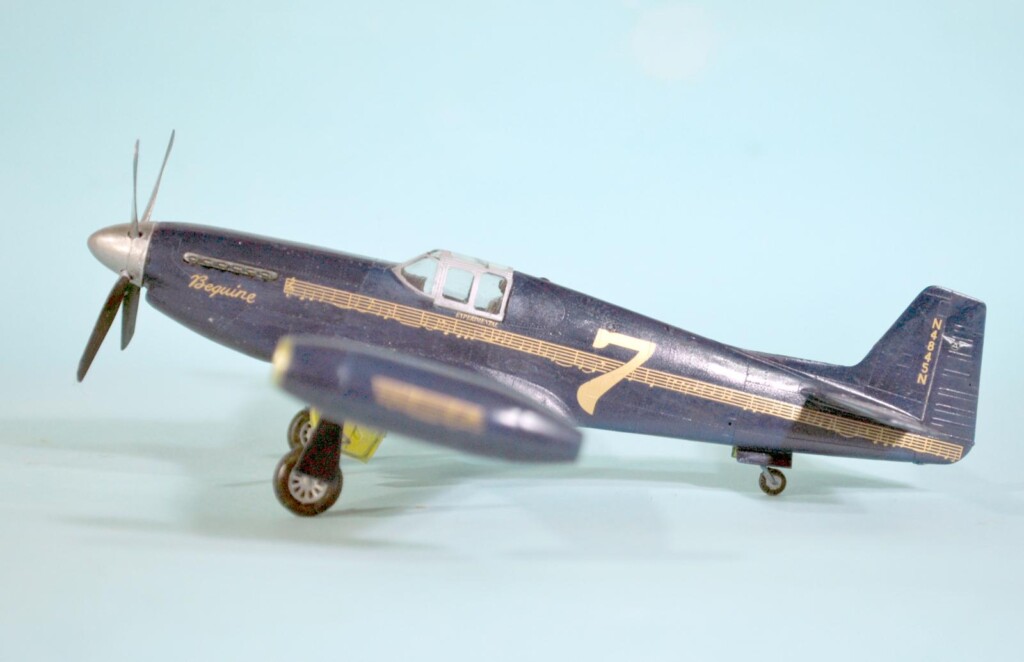

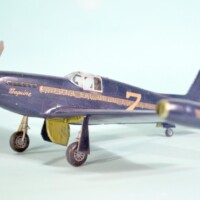





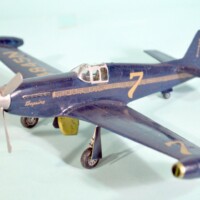




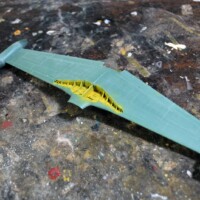
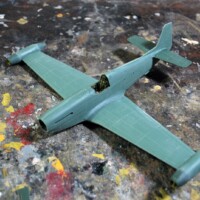
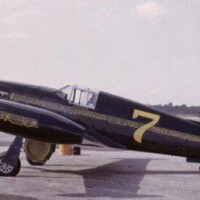

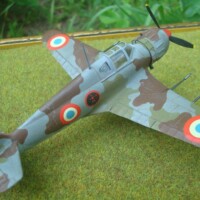
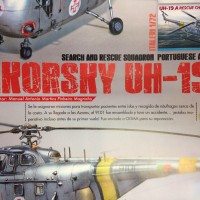
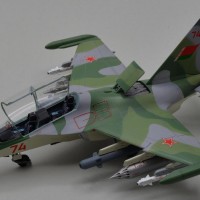
This racer really came out great, Tom (@tcinla), especially considering it is resin. I have read several reviews of the Halberd complete kits and they all talk about how well they go together. I have never built an all-resin kit, but I may have to try one soon. Thanks for sharing.
A real nice one Tom!
Very interesting colour scheme (hand painted?). Excellent and fascinating history of the aircraft as well.
airbrushed
Excellent job and an extremely interesting story, Tom!
A beautiful result on this racer, Tom @tcinla
Do easy resin kits really exist, I have the impression that resin is far more difficult to work with than plastic.
Great supporting article, thanks for that.
It's more brittle, handle with care. But a well-designed, well-cast resin kit like this is indeed easy.
That's a beautiful competitor.
I like racing machines of all kinds and I like this one very much.
Beautiful resin racer, Tom.
More resin excellence, Tom. I really like this one. Very interesting story too.
Another beauty, Tom. Looks like another winner from Halberd. Interesting history on this airplane and interesting bio on Mr. Odom
Now that is a unique bird! Looks great Tom, though you still haven't convinced me into resin yet...!